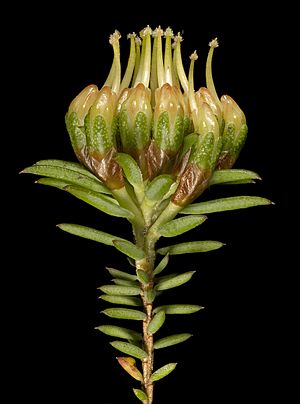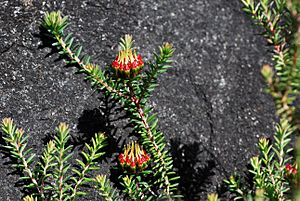Darwinia hortiorum facts for kids
Quick facts for kids Darwinia hortiorum |
|
|---|---|
 |
|
| Darwinia hortiorum | |
 |
|
| Conservation status | |
| Scientific classification | |
| Genus: |
Darwinia
|
| Species: |
hortiorum
|
The Darwinia hortiorum is a special plant that belongs to the Myrtaceae family, also known as the myrtle family. It only grows naturally in Western Australia, meaning it's endemic there. This plant is a small, bushy shrub with lots of branches and tiny leaves. Its flowers grow in groups of up to twenty. These flowers have shiny petals that can be pale yellow or reddish. They also have thick, dark green sepals and papery brown bracteoles around them.
What it Looks Like
The Darwinia hortiorum is a shrub that grows upright or spreads out. It has many branches that grow close together, making it look compact. It usually grows to be about 0.8 metres (2.6 ft) tall and 0.8 m (2.6 ft) wide. This plant is smooth, meaning it has no hairs. It has one main stem at the bottom, with branches spreading out. These main branches have many smaller, leafy branches growing upwards.
Older stems of the plant have reddish-brown, papery bark that peels off. The leaves are arranged one after another along the stem. They are spaced out and are narrow, shaped like an egg or almost like a line. Each leaf is about 3–6 mm (0.1–0.2 in) long and 1–2 mm (0.04–0.08 in) wide.
The flowers grow in groups at the ends of the branches. Each group has between 14 and 22 flowers. Every flower has five smooth, shiny, yellowish petals that have a touch of crimson red. It also has five bumpy, dark green sepals with clear oil glands (tiny bumps that produce oil). There are also two papery brown bracteoles (small leaf-like parts) near the flower.
Inside the flower, there are ten stamens (the parts that make pollen) that stick out between the petals. The style (a part of the female reproductive organ) is curved towards the center of the flower group. This plant blooms between late September and early December. The Darwinia hortiorum is quite unique and doesn't have many close relatives. However, it looks a bit like another plant called Darwinia thymoides, which grows in the same areas.
How it Got its Name
The Darwinia hortiorum was officially described for the first time in 2010. This was done by a scientist named Kevin Thiele. He published his description in a scientific paper called Darwinia hortiorum (Myrtaceae: Chamelaucieae), a new species from the Darling Range, Western Australia. This paper appeared in a journal called Nuytsia.
The second part of the plant's name, hortiorum, was chosen to honor Fred and Jean Hort. They are described as "enthusiastic field botanists, expert plant-hunters and national treasures." This means they love studying plants in nature, are very good at finding them, and are highly valued. Fred and Jean Hort were the first people to collect samples of D. hortiorum in 2008. They found these plants growing on granite rocks in the Monadnocks Conservation Park.
Where it Grows
This special shrub is found in a small area near Wandering in the South West part of Western Australia. It grows in five different spots within the Jarrah Forest biogeographic region. This region is a natural area with similar plants and animals.
The plant covers an area of about 9 square kilometres (3 sq mi) in the Monadnocks Conservation Park and the nearby Boonering State Forest. All the places where this plant is known to grow are among granite rocks and the small streams that flow from them. It grows in shallow, clay-like soil that comes from granite, mixed with broken rocks.
Other plants that often grow near Darwinia hortiorum include Allocasuarina humilis, different types of Andersonia, Grevillea bipinnatifida, Grevillea manglesii, Banksia recurvistylis, Hakea undulata, Hakea trifurcata, Verticordia insignis, Calytrix depressa, Xanthorrhoea preissii, and Hibbertia hypericoides.


